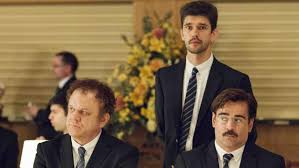THE GOOD, THE NOT SO BAD AND THE UGLY: AFI 2015, PART 3: NO RESERVATIONS-Movie Reviews of the movies The Lobster and Youth by Howard Casner
Posted: December 2, 2015 | Author: Donald | Filed under: Uncategorized | Tags: Ben Whishaw, Collin Farrell, Efthymis Filippou, Garry Moutaine, Harvey Keitel, Jane Fonda, John C. Reilly, Lea Seydoux, Michael Caine, Olivia Coleman, Paola Sorrentino, Paul Dano, Rachel Weisz, The Lobster, Yorgos Lanthimos, Youth | 1,076 Comments »First, a word from our sponsors: I am now offering a new service: so much emphasis has been given lately to the importance of the opening of your screenplay, I now offer coverage for the first twenty pages at the cost of $20.00. For those who don’t want to have full coverage on their screenplay at this time, but want to know how well their script is working with the opening pages, this is perfect for you. I’ll help you not lose the reader on page one.
Ever wonder what a reader for a contest or agency thinks when he reads your screenplay? Check out my new e-book published on Amazon: Rantings and Ravings of a Screenplay Reader, including my series of essays, What I Learned Reading for Contests This Year, and my film reviews of 2013. Only $2.99. http://ow.ly/xN31r
and check out my Script Consultation Services: http://ow.ly/HPxKE
Warning: SPOILERS
 Two movies at AFI were brought there by filmmakers who worked with an English speaking cast for the first time. Screenwriter Efthymis Filippou and writer/director Yorgos Lanthimos, from Greece, previously gave the world the oddity Dogtooth and, appropriately enough, now give us the quite possibly even odder oddity, The Lobster.
Two movies at AFI were brought there by filmmakers who worked with an English speaking cast for the first time. Screenwriter Efthymis Filippou and writer/director Yorgos Lanthimos, from Greece, previously gave the world the oddity Dogtooth and, appropriately enough, now give us the quite possibly even odder oddity, The Lobster.
The Italian filmmaker Paola Sorrentino, who directed and co-wrote the absolutely brilliant and ravishing The Great Beauty, has now given us Youth.
Overall, they have all succeeded rather well in spite of the fact that they are creating in a language that is not their native tongue.
Efthymis Filippou and Yorgos Lanthimos’ The Lobster is set in one of those dystopian futures and is located in The City, a place where everyone must be in a relationship, and if you are not (say you are widowed), you go to a hotel with others like yourself and are given 45 days to fall in love. If, at the end of your stay, you find yourself yet single, you are turned into the animal of your choice. Read the rest of this entry »
Movie Review of SAVING MR. BANKS by Howard Casner
Posted: December 24, 2013 | Author: Donald | Filed under: Uncategorized | Tags: B.J. Novak, Collin Farrell, Emma Thompson, Jason Schwartzman, John Lee Hancock, Kathy Baker, Kelly Marcel, Mary Poppins, P.L. Travers, Sue Smith, Tom hanks, Walt Disney | 8,793 Comments »When Emma Thompson first appears on screen as children’s author and Mary Poppins’ creator P.L. Travers (sorry, that’s Mrs. Travers to me) in Saving Mr. Banks, she’s pinched face, irritable, unpleasant and deeply unhappy, possessing the personality of the second nanny in the horror film The Omen.
I know she’s an unlikable human being, so unlikable she probably makes dogs run for their lives just by glaring at them. But from the first moment I saw her, I loved her and was on her side. I mean, she has one of the best “save the cat” moments in recent films. When she can’t get her suitcase into the overhead rack and a mother with a baby comes to her rescue and offers to move her own bag to give her room, Travers responds by asking whether the child is going to be a nuisance since it’s an eleven hour flight. Now, if you can’t adore someone like that, then you just don’t have a heart.
I suppose part of her immediate appeal to me could be because I’m a screenwriter as well, and so I could easily identify with her fears of what a producer might do to her beloved creation Mary Poppins. And she has good reason for these fears, with the constant complaints from authors whose novels and plays Hollywood has, well, what’s a good PG-13 word for it—misinterpreted, distorted, altered, disfigured, twisted, warped, raped, sodomized up the anus cavity with a heated iron rod like Edward II…but I digress.
But it’s not just that. There’s more to it than just that. When she arrives in Los Angeles and steps off that plane, she’s confronted by a constant barrage of “it’s a small, small world” happy people with toothsome smiles out of The Sound of Music and a city so brightly lit with mind-numbing sunshine, that all I wanted to do was slap those merciless grins off of everybody’s faces and ask God to do to the city what Mark Robson did to it in Earthquake.
So when she constantly throws her Noel Coward-like snarky comments at one and all; or school teacherly corrects the screen and song writers of the movie to be when they make the somewhat dubious claim that Dick Van Dyke is one of the greats; or she gets so frustrated she throws the screenplay that has so disgusted her out the window, I was yelling “you go, girl” (well, no, I didn’t yell it, I was in a movie theater, after all, but you know what I mean).
And then it happens, the exact same thing that happens to Travers in the movie. The charm of Disneyland and Los Angeles just wears you down and you have no choice but to succumb to it all. It’s inevitable. And there’s no shame in it because it happens to god bless us one and all who transpose themselves to this bright and shining city on the sea.
And so, like everyone who has come before her, by the end of the film, Travers has embraced the sordid cheeriness of the City of Angels and gives up fighting for control of her story, letting “Walt, you have to call me Walt. Mr. Disney is my father” turn her no-nonsense, all business nanny into a singing, dancing, twinkling (“and the magic word is”) Julie Andrews.
Saving Mr. Banks is the Hitchcock of 2013. Based as was Hitchcock on a true Hollywood story of the making of a classic movie, it also leaves a lot to be desired when it comes to the facts. But also like Hitchcock, it’s one of the most purely enjoyable films of the year. The screenplay by Kelly Marcel and Sue Smith is witty and bright and full of supercalifragilisticexpialidocious (OMG, believe it or not, that did not come up wrong on spell check; spell check actually has that made up word in it) energy and John Lee Hancock’s direction is taut with expert timing.
It’s not perfect by any means. The psychology is simplistic and obvious, and there are scenes that aren’t as convincing as they might be, as when Don DaGradi, Mary Poppins’ screenwriter, gets Travers to tap her toes and dance with him (calling Joseph Campbell, calling Joseph Campbell, I think a couple of steps in the hero’s journey got left out here). And some of the visuals are painfully on the nose (as the change in Travers’ fashion from sensible, brown tweed to free flowing blue and white cotton after she signs over her creation’s life to Disney’s implacable will).
But gosh darn it all to heck, it just doesn’t matter. You can point out the problems and bewail and bemoan it all, but that won’t stop the whole thing from winning you over and thoroughly delighting you. Even when it doesn’t work, oh, my, does it work.
The cast is one of the finer ones of the year. Both Emma Thompson, as Travers, and Tom Hanks, as Disney, seem to have had something of a Renaissance here. Neither has really been doing anything of real note lately. Thompson had been hiding out in small supporting roles in such movies as Brideshead Revisited, Pirate Radio and seasonal revivals of Love Actually. But now she’s back in a lead and she’s brought all her glory with her.
And Hanks, who had been making some of the most painfully uninteresting movies of late that a major actor could make (Cloud Atlas, Extremely Loud & Incredibly Close and Larry Crowne), gives the second of two remarkable performances this year, first in Captain Phillips, and now in Saving Mr. Banks, where he brings a mythic Walt Disney down to earth (and does one of these impersonations where whenever I think of the original, now all I’ll see is Hanks).
Maybe both just needed to go through a period of adjustment as they grew older and had to reinvent themselves in order to reinvigorate their careers (most actors do).
But the movie also has some of the most imaginative casting in supporting roles as well, from Wes Anderson refugee Jason Schwartzman as one half of the Sherman brothers song writing team (B.J. Novak is also solid as the other half); Kathy Baker, who really has nothing to do as Disney’s secretary, but she makes the most of it anyway (she has a terrific bit at the end where she’s laughing as Disney comes into the office because she knows something he doesn’t); and perhaps most wonderful of all, Collin Farrell, who gives a magical and haunting performance as Travers’ dipsomaniac father in the moving and heartfelt flashback episodes.
So in the end, is Saving Mr. Banks a good movie? Sure it is. Even very good, I’ll venture to say. Is it more than that? God, no. But like Los Angeles and Disneyland, it’s easier not to fight it and just enjoy the hell out of it. It’s the only way you’ll get out alive. Take it from Mrs. Travers.










 First, a word from our sponsors: I am now offering a new consultation service: so much emphasis has been given lately to the importance of the opening of your screenplay, I now offer coverage for the first twenty pages at the cost of $20.00. For those who don’t want to have full coverage on their screenplay at this time, but want to know how well their script is working with the opening pages, this is perfect for you. I’ll help you not lose the reader on page one.
First, a word from our sponsors: I am now offering a new consultation service: so much emphasis has been given lately to the importance of the opening of your screenplay, I now offer coverage for the first twenty pages at the cost of $20.00. For those who don’t want to have full coverage on their screenplay at this time, but want to know how well their script is working with the opening pages, this is perfect for you. I’ll help you not lose the reader on page one.  When I saw writer/director Yorgos Lanthimos and writer Efthymis Filippou’s earlier film Dogtooth, I must be honest and say I didn’t have the most favorable reaction and many might consider that odd.
When I saw writer/director Yorgos Lanthimos and writer Efthymis Filippou’s earlier film Dogtooth, I must be honest and say I didn’t have the most favorable reaction and many might consider that odd. I think their might be a competition for the use of the geekiest hero in thrillers these days.
I think their might be a competition for the use of the geekiest hero in thrillers these days.
